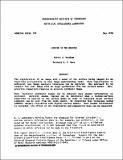| dc.contributor.author | Woodham, Robert J. | |
| dc.contributor.author | Horn, Berthold K.P. | |
| dc.date.accessioned | 2008-04-10T16:01:03Z | |
| dc.date.available | 2008-04-10T16:01:03Z | |
| dc.date.issued | 1976-05 | |
| dc.identifier.uri | http://hdl.handle.net/1721.1/41139 | |
| dc.description | This report describes research done at the Artificial Intelligence Laboratory of the Massachusetts Institute of Technology. Support for the laboratory's artificial intelligence research is provided in part by the Advanced Research Projects Agency of the Department of Defense under Office of Naval Research contract N00014-75-C-0643. | en |
| dc.description.abstract | The registration of an image with a model of the surface being imaged is an important prerequisite to many image understanding tasks. Once registration is achieved, new image analysis techniques can be explored. One approach is to compare the real image with an image synthesized from the surface model. But, accurate comparison requires and accurate synthetic image.
More realistic synthetic images can be obtained once shadow information is included. Accurate shadow regions can be determined when a hidden-surface algorithm is applied to the surface model in order to calculate which surface elements can be seen from the light source. We illustrate this technique using LANDSAT imagery registered with digital terrain models. Once shadow information is included, the effect of sky illumination and atmospheric haze can be measured. | en |
| dc.description.sponsorship | MIT Artificial Intelligence Laboratory | en |
| dc.language.iso | en_US | en |
| dc.publisher | MIT Artificial Intelligence Laboratory | en |
| dc.relation.ispartofseries | MIT Artificial Intelligence Laboratory Working Papers, WP-169 | en |
| dc.title | Looking in the Shadows | en |
| dc.type | Working Paper | en |
